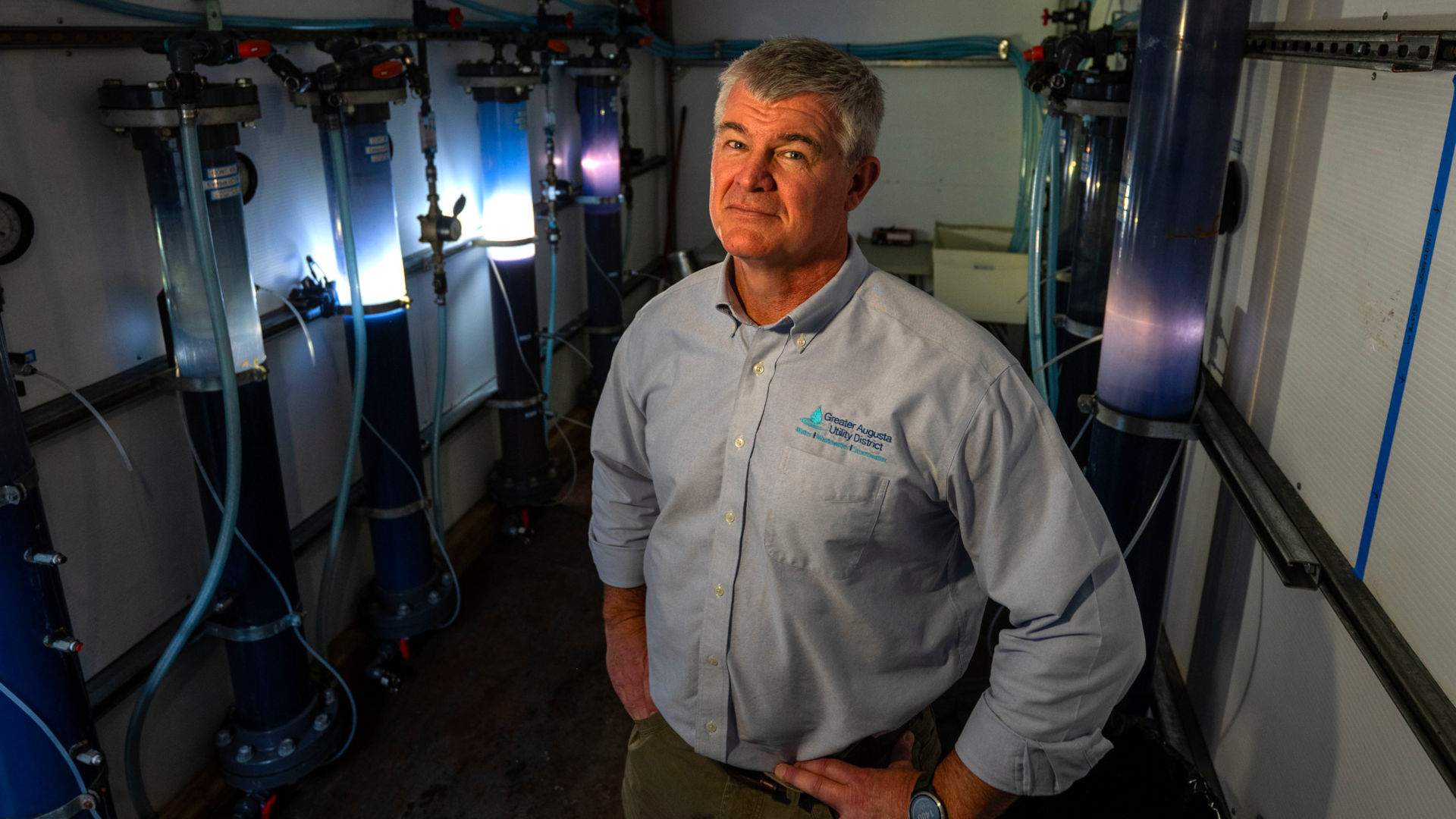Baring Teeth: The Long Battle Over Fluoride Comes to a Head
In a wood-paneled federal courtroom in downtown San Francisco, experts and litigators gathered last month for hearings on an old question: Is it safe to add fluoride to drinking water?
Around 210 million Americans today have access to artificially fluoridated tap water, and the policy has had a pronounced effect on oral health by reducing tooth decay. It’s widely hailed as a public health success story. In the current lawsuit, plaintiffs are taking a long-standing and, to many experts, provocative stance, arguing that water fluoridation poses a risk to human health, and that the Environmental Protection Agency is obligated to address the issue. The outcome of the case could effectively end water fluoridation in United States. A ruling from Judge Edward M. Chen is expected soon.
In some circles, just entertaining questions about fluoride safety is synonymous with tinfoil-hat conspiracy theorizing. After all, some anti-fluoride activists have, over the years, made wild claims — for example, that fluoride is a form of communist mind control — that don’t have any evidence to back them up.
The lawsuit, though, has put a consequential spotlight on a real scientific debate that has been roiling public health researchers for the past several years.
Today, there is a modest body of evidence suggesting that fluoride, at doses considerably higher than what’s generally in the water, might be bad for human brains, in particular developing fetal brains. A few studies also suggest possible harms from the levels that many municipalities in the U.S. currently add to their drinking water. And most scientists involved agree that the uncertainty warrants more research.
What to make of that uncertainty — and how it should be communicated to the public — has divided researchers. Some experts, especially among dentists, think the evidence is far too weak to be making policy prescriptions. “The best available evidence just doesn’t suggest that this is a real association at the levels to which people are exposed to fluoride in fluoridated water,” said Scott Tomar, a dentist and oral health epidemiologist at the University of Illinois Chicago.
But some current and former federal scientists, as well as academic researchers in toxicology and environmental health, say there’s reason for concern. Some also suggest that something else is going on: Faced with uncomfortable data, they say, water fluoridation proponents have attacked and obstructed fluoride research. And rather than allowing the scientific debate to flourish in the open, dental groups and some public health experts have targeted researchers who study fluoride and brain development, in a pattern that some characterized as suppressing important science.
“I see this as an infringement of scientific integrity, that the scientists have been prevented from getting their information out.”
Central to the debate is an unpublished government report, produced by a little-known federal program, that has been subject to years of bureaucratic wrangling. In fact, that wrangling contributed to delaying the EPA lawsuit for more than two years as the judge awaited the report’s publication, before finally settling on the use of draft documents. They are now a central piece of evidence in the case.
Fluoride safety is exactly the kind of issue the National Toxicology Program was designed to tackle: It’s an interagency program, housed at the National Institutes of Health, that investigates whether things like the “forever chemicals” PFAS and cellphone radiation are harmful to people’s health. In 2016, the NTP asked its scientists to gather all the existing scientific research on fluoride, analyze the data, and say something authoritative about whether fluoride might be damaging to human brains.
After years of research and peer review, a draft of the report concluded there might be reason for concern, mostly at levels of fluoride exposure higher than most, but not all, Americans experience.

Brian Berridge, a former pharmaceutical industry scientist, led day-to-day operations at the National Toxicology Program when controversy over the agency’s fluoride report came to a head. In 2023, Berridge retired, frustrated with the report’s repeated delays.
Visual: Courtesy of Brian Berridge
In April 2022, the NTP group was ready to publish its findings. “That’s when the wheels fell off,” said Brian Berridge, a former pharmaceutical industry scientist who led NTP’s day-to-day operations at the time. Dental organizations obtained internal drafts of the report. They then began to lobby federal officials, according to documents obtained via public records requests by advocates opposed to water fluoridation. Officials from other agencies, including the Food and Drug Administration and the Centers for Disease Control and Prevention, registered concerns. The report was soon tracked into yet another round of review, blindsiding scientists who thought it was done.
Berridge grew frustrated. “After 17 years in the industry, I’ve seen efforts to modify messages to fit commercial interests,” he wrote in an email to NIH colleagues that May. “I wasn’t party to that there, and I’m not game to do that here.”
Today, nearly two years after NTP scientists were prepared to tell the public that pregnant women should monitor their fluoride intake, and that too much fluoride may “negatively affect children’s cognition and neurodevelopment,” the project remains in a kind of bureaucratic limbo.
Berridge retired from the agency in the spring of 2023, upset by the handling of the fluoride report. “That’s not the way I want to do science,” he said. “So I decided to do something different.”
Fluoride strengthens teeth because teeth are like living rocks: tissue sheathed in a mesh of crystals called enamel. Unlike bone, which grows and mends itself over a person’s lifetime, teeth don’t self-repair. When fluoride washes over tooth enamel, in a smear of toothpaste or a swish of water, some of it can be incorporated into those crystals, helping to repair and strengthen the tooth. The process helps keep damage and decay at bay.
The stuff is found nearly everywhere: in the air and in the dirt; in bottles of soda and in tea leaves. A typical cup of black tea contains fluoride at a concentration of 2.5 milligrams per liter. A liter of ocean water contains around 1.2 mg of fluoride.
In some places, abundant fluoride leaches from soil and rock into the local water supply. A liter of tap water in parts of Cypress, Texas, for example, contains 3.81 mg of fluoride. Meanwhile, in Portland, Oregon, the number is closer to zero.
Researchers in the early 20th century noticed that people living in areas with high levels of fluoride in the drinking water had fewer cavities, and by the 1940s, a campaign was underway to add fluoride to municipal water supplies — today generally at a concentration of 0.7 mg/L.


Almost immediately, some communities objected to having a chemical added to the water supply, even if it often occurred naturally. Portland, for example, has long resisted fluoridation. One of the very first U.S. towns to add fluoride to its water supply, Stevens Point, Wisconsin, did so in secret, before a planned public referendum, fueling wider opposition to the practice, according to a 1985 paper by the historian Donald R. McNeil.
Over the years, the policy came to be associated with broader suspicions about government and public health authority. “The fluoridation question is almost tailor-made for endless controversy in a free-wheeling democratic society,” McNeil wrote, adding that fluoridation’s opponents included “not only the fanatics, the fearful, and the vendors of snake oil, but also a goodly proportion of those Americans who simply distrust authority, government, science.”
More recently, the anti-vaccination activist and presidential candidate Robert F. Kennedy Jr. has promised to halt water fluoridation if he’s elected to the White House.
There’s extensive evidence that fluoridation dramatically improved dental health. In 1999, the CDC named water fluoridation as one of the 20th century’s 10 greatest public health achievements, alongside family planning and vaccination. But since at least the 1980s, there have also been scientists — some working within the federal government — who worry that ingesting fluoride could have toxic effects.

A 1975 poster issued by the United States National Caries Program advocates for fluoride use. Extensive evidence has shown that fluoridation dramatically improves dental health.
Visual: Smith Collection/Gado/Getty Images
Those concerns were bolstered in the 1990s and 2000s by research coming out of China. In 1991 a team of Chinese disease researchers published a report from Biji village, in the landlocked Shanxi Province of northern China. At the time, the researchers reported, the drinking water in the village had unusually high fluoride levels of 4.55 mg/L. They administered IQ tests to 320 children there, and then compared the scores to those of children in a nearby village, Jiaobei, where fluoride levels were below 1 mg/L. The children in Jiaobei, they found, had significantly higher IQs.
In the next few years, other researchers in China repeated that basic setup: high fluoride village, low fluoride village, cognitive tests. Many scientists today say those and other studies were poorly done, and that there are lots of things besides fluoride that could be affecting any reported differences in IQ. But the consistency of the results raised concerns: Again and again, the research found an association between higher fluoride exposure and lower IQ.
In 2002, the EPA asked a panel of experts to review the evidence on fluoride safety. Based on the data from China, as well as studies conducted in lab rats, the panel determined that there was reason to pay attention. “More research is needed to clarify the effect of fluoride on brain chemistry and function,” they wrote in a 2006 report.
It was unclear, the EPA advisers noted, whether the China data was relevant to most U.S. communities. The dose makes the poison, toxicologists say, and the study subjects in China were generally drinking water with 2.5 mg/L or more of fluoride, well above the recommended levels for U.S. tap water.
Still, there are signs that some federal scientists felt concern. In a 2015 report, the U.S. Public Health Service amended its recommended level of fluoride in U.S. public water supplies, from a range of .7 to 1.2 mg/L to a standard of .7 mg/L. The stated reason was to reduce the unsightly tooth mottling that can occur from prolonged fluoride exposure. But a draft of the report, circulated among federal officials in 2014 and obtained by Undark, suggests that concerns about the possibility of neurotoxic effects had also played a role. “While additional research may address identified gaps in knowledge,” the draft said, “HHS seeks to protect health by lowering the recommended fluoride concentration.”
When the report was published the next year, that paragraph had been removed.
Some scientists did answer the call for more research on fluoride and brain development. Among them was Christine Till, a neuropsychologist at York University in Canada.
Till was a newly tenured professor in 2016, studying the impact of chemical exposures, when she received her first grant to look at possible links between fluoride and brain development. A colleague had suggested studying the Maternal-Infant Research on Environmental Chemicals cohort, or MIREC, in Canada. Starting in 2008, researchers had collected urine and other samples from pregnant women. They had also asked the women lots of questions about their lifestyle and consumption habits. After the babies were born, and as the children aged, the scientists then tested many of the children for all sorts of things. The goal was to create a dataset scientists could use to look for associations: for example, if exposure to a certain chemical in the womb was connected with lowered IQ scores years later.
Till and several colleagues successfully got permission from MIREC to analyze the urine of those women, measuring the amount of fluoride in each sample. Her team also reviewed women’s self-reported consumption patterns, to estimate how much fluoride they were taking in from tap water and other sources during their pregnancies. And they looked at the IQ scores of the children when they were 3 or 4 years old, to see if there was some kind of link between fluoride intake during pregnancy and cognitive performance.
“The fluoridation question is almost tailor-made for endless controversy in a free-wheeling democratic society.”
Their team included experts in environmental health and epidemiology, as well as a dental public health expert, E. Angeles Martinez Mier, a professor at the Indiana University School of Dentistry who has served on the American Dental Association’s National Fluoridation Advisory Committee.
“I really was expecting not to find anything,” said Rivka Green, a lead researcher on the MIREC study who undertook the work as one of Till’s graduate students. Some of Green’s relatives are dentists, and they made fun of her for even considering the topic. She had no particular concern about fluoride, she recalled: “Everyone says it’s safe. Let’s show it safe. And that’s it. That would be great.”
One day in 2017, Green, who was pregnant and driving home from an appointment with her obstetrician, got a call from Till. The statistician on their team had just run the numbers, Till told her. And something had shown up in the data — something significant. “There’s a finding,” Till told Green. There seemed to be some association in the data between higher fluoride exposure and lower IQ.
In 2019, the team published their results in JAMA Pediatrics, a prestigious journal. “The decision to publish this article was not easy,” the journal editor, pediatrics researcher Dmitri Christakis, wrote in a brief note accompanying the paper. “Given the nature of the findings and their potential implications, we subjected it to additional scrutiny.”

Till, Green, and their colleagues had found that women with higher self-reported fluoride exposures had, on average, children with IQs that were around 3 points lower. And higher urinary fluoride measures during pregnancy were associated with lower levels of IQ in boys, but not girls.
That kind of change is small enough that it could have gone unnoticed, according to environmental health experts. But a drop of three IQ points still could have an effect. “That is the average of some people who will lose six points of IQ. And some people will only lose one or two,” said Howard Hu, a physician and epidemiologist at the University of Southern California. That kind of difference, he said, is comparable to the effect that leaded gasoline had on IQ — before its use was banned by Congress. “The effect of fluoride, from what we can see, is not that different from the effect of lead, when we look at the actual magnitude of the impact on IQ,” Hu said.
Was the finding true? The study was a kind of observational study, meaning it could show a correlation between fluoride levels in the urine and slightly lower IQ, but not prove that fluoride ingestion caused the decline.
Such studies are widely used to research environmental toxins, including lead. But in related fields that search for links between diet and certain outcomes — most notably nutritional epidemiology — such studies can be famously finicky, giving mixed results. And experts were quick to raise a host of pointed questions about Till and her team’s paper: How reliable were IQ tests of 3 and 4-year-olds? Could the findings be biased by differences among the people administering the IQ tests? Why did the IQ drop sometimes show up in boys but not girls? And could a few urine samples — or, for that matter, self-reports on beverage consumption — actually provide a good measure of how much fluoride makes it to a developing fetus? (Some experts say such data cannot show such a connection; others point to research suggesting that it can, including a 2020 study from scientists at the University of California San Francisco that found a link between urinary fluoride levels and levels of fluoride in amniotic fluid.)
One other issue: If fluoride did affect the brain, nobody really knew how. In other words, there was no clear mechanism by which this one chemical was affecting brain development, although Till and others have proposed that an effect on thyroid function could be one mechanism behind it.
“Everyone says it’s safe. Let’s show it safe. And that’s it. That would be great.”
Still, some experts who were not involved in the study told Undark it was a strong piece of research. The MIREC research was some “of the very best, actually, in the field,” said Akhgar Ghassabian, an environmental epidemiologist at New York University.
“It’s one study. It’s a good study. And I would say the results are relevant,” said David Eaton, an emeritus professor at the University of Washington and a past president of the Society of Toxicology. “But it’s really hard to know whether the magnitude of the effect and the reproducibility of that effect is the end of the story.”
In a recent Zoom conversation, Green acknowledged that the study had limitations. But, she said, that was true of any study. “At first I was, you know, maybe this is just a standalone, it’s a fluke — which happens,” she said. “We know that happens. And that’s why we don’t rely on one study.”
The NTP process is built, in part, on the insight that no single study is definitive, especially on complicated questions about environmental hazards. Instead, the goal is to do a methodical review of every single study published on a given question, and then look for patterns in that entire body of evidence.
John Bucher helped pioneer those methods at NTP. The soft-spoken toxicologist joined the program in the 1980s, and eventually became its associate director in 2007. In retirement, Bucher still works on some projects for NTP, and he’s one of the lead authors of the fluoride report.
In a series of conversations this winter, from his home in the forested piedmont of central North Carolina, Bucher reflected on the years he and his colleagues had spent reviewing the body of literature on fluoride — including research like the Shanxi study, as well as the work of Till and her colleagues. Compared to scientific research on other hazardous substances, he said, the fluoride literature shows a fairly clear pattern. “My impression is that the findings are generally more consistent in direction of effect,” he said. “That is, they tend to show deficiencies, at least in IQ.”
“As the literature continued to accumulate we were more and more convinced that there were no single flaws that could explain the consistency in the findings.”
A similar study to Till and Green’s paper, conducted in Mexico, also found an association between higher levels of fluoride in pregnant women’s urine and lower IQ. Meanwhile, recent studies on mothers and their children in Spain and Denmark, using similar methods, did not find any clear negative effects from fluoride. (Several researchers have questioned the Spanish result, which showed that higher fluoride levels increased boys’ IQ scores by as much as 15 points.)
In the most recent publicly available draft, the NTP report identifies 19 studies on fluoride and children’s IQ that it rates as high-quality. Of those, 18 find some adverse effect from fluoride. Of the 53 lower-quality studies reviewed by Bucher and his colleagues, 46 suggest some negative effect from fluoride on IQ.
“As the literature continued to accumulate,” Bucher said, “we were more and more convinced that there were no single flaws that could explain the consistency in the findings.”

Most of those studies look at fluoride exposures higher than 1.5 mg/L — in other words, more than double the levels founds in most Americans’ drinking water. Bucher stressed that the report is not — and was never intended to be — an evaluation of the safety of adding fluoride to water. “We don’t have enough data to make any statement with any certainty about it at the lower levels,” he said.
Still, even the findings at higher levels of fluoride may be relevant to some Americans. Individual fluoride exposure can vary a lot, depending on what a person drinks. And according to one recent estimate, more than 2.9 million Americans are served by water utilities that deliver tap water with levels of fluoride at or above 1.5 mg/L. According to CDC data, that includes utilities in Troy, Missouri (12,116 people served; 2.31 mg/L); Seminole, Texas (8,549 people served; 4.40 mg/L); and Abercrombie, North Dakota (258 people served; 2.29 mg/L).
Such communities “are clearly in the range that we would predict would be — we would say they would be presumed neurotoxicants,” said Bucher.
By April 2022, the NTP report was poised to be published. It had, by that point, undergone peer review from five external experts, and been subjected to two rounds of review by a National Academies of Sciences, Engineering, and Medicine panel. In the second round, reviewers mostly took issue with some of the report’s language, rather than the underlying science, and urged the NTP to make clearer that “little or no conclusive information can be garnered” from the report “about the effects of fluoride at low exposure concentrations.”
“Overall, I feel that they have been responsive to many comments,” said Ghassabian, the NYU professor, who served on the NASEM committee.
In the spring of 2022, the NTP notified other agencies that the report was coming. Soon after, some officials expressed concerns about the way the science was being communicated, seemingly worried that it could undermine community water fluoridation programs. At the same time, dental organizations had obtained the document and were raising concerns with officials at the CDC, according to emails obtained via public records requests and shared with Undark.
The report looked to many dental experts like yet another assault on a public health program. According to emails and public statements from around the time, leaders in the field saw the report as issuing alarming conclusions, with too little context, based on evidence that was, at best, highly tentative. They worried that NTP had overstated the quality of some fluoride studies.
“We don’t have enough data to make any statement with any certainty about it at the lower levels.”
According to the internal emails, the report received scrutiny from top government officials, including the NIH’s acting principal deputy director at the time, Tara Schwetz, and assistant secretary of health Rachel Levine. In early May 2022, Rick Woychik, the director of NTP, halted publication. Instead, the report and an accompanying analysis of fluoride research would undergo another round of review, this time overseen by an independent board of scientists that advises the NTP.
The entire process has struck some in the federal government as unusual. “It just seems like it’s just stretching out the scientific review process,” said one federal official with detailed knowledge of the report, who spoke on condition of anonymity because of concerns about professional repercussions. “It’s kind of hard to defend, I think, for something that’s actually slated to just be submitted to a journal for peer review,” the official added.
The official also questioned the decision to allow agencies like the CDC — which has long promoted water fluoridation — to weigh in on the NTP’s research. “You’re talking about having that document reviewed by agencies who have a vested interest in the policy of fluoride,” the official said, adding that the review process now appeared entangled with various policy biases. “That, to me, is really when it crosses the boundary.” (A CDC spokesperson said that the agency routinely reviews draft reports on “emerging science” from other parts of the federal government in order “to assure that our recommendations maximize benefits while minimizing any potential harms.”)
Support Undark Magazine
Undark is a non-profit, editorially independent magazine covering the complicated and often fractious intersection of science and society. If you would like to help support our journalism, please consider making a donation. All proceeds go directly to Undark’s editorial fund.
Linda Birnbaum, a toxicologist who served as director of both NTP and the National Institute of Environmental Health Sciences from 2009 until 2019, also criticized the review process. “I see this as an infringement of scientific integrity, that the scientists have been prevented from getting their information out,” she said. That information, she argued, has implications for public health: “I think the data is overwhelmingly clear that fluoride is associated with the potential for neurodeficits.”
Christine Flowers, a spokesperson for the National Institute of Environmental Health Sciences, which houses the NTP, declined to make the program’s current director, Rick Woychik, available for an interview. The ongoing delay in publication, she wrote in an email, “was to ensure that we get the science right.”
So far, progress on the main report appears to be stalled. According to Bucher, the authors have received no revisions to the document since September 2023. The accompanying analysis paper, though, is finally moving forward. The next step would be submission to a journal — where it will undergo yet another round of peer review.
For some scientists, the NTP saga has echoes of another dispute: the response to Christine Till and her team in Canada, after their 2019 paper was published in JAMA Pediatrics.
In 2021, following a series of letters to York University and other institutions criticizing the paper, a group of academics and dental leaders filed a series of misconduct complaints with the researchers’ institutions, as well as the U.S. federal government, which had funded the study.
“That’s fucking mean. I mean, that’s terrible” said Hu, the physician and epidemiologist at the University of Southern California, who previously served as dean of the Dalla Lana School of Public Health at the University of Toronto. Hu was not involved with the paper, but he has collaborated with Till on other research, and he helped lead influential fluoride studies in Mexico. “You don’t do that,” he said of the complaints, “unless you actually have evidence of scientific misconduct.”
Such allegations are typically reserved for cases of data fabrication and fraud, and they can bring immediate consequences, delaying research, freezing funding, and taking up large amounts of a researcher’s time.
“I think the data is overwhelmingly clear that fluoride is associated with the potential for neurodeficits.”
For the scientists who signed the complaints, the stakes felt high. Among them was Jennifer Meyer, an associate professor of public health at the University of Alaska, Anchorage. Meyer first became interested in fluoride when she moved to Juneau, Alaska, a number of years after the city halted water fluoridation. Dentists, she said, observed an immediate rise in tooth decay — a finding that Meyer and two colleagues backed up with hard data in later research.
It was galling for Meyer to see Till’s team make public statements recommending that pregnant women limit their fluoride intake. It seemed to her that the scientists, based on what she saw as one deeply flawed study, were in effect issuing public health advisories. Such activity, she suggested, might be worth silencing: “If you’re out there terrifying the public about a well-known public health intervention on which you have you have no basis to make that claim, and yet you’re continuing to do it, then it becomes, I think, a step too far,” Meyer said. Some people may see that as academic free speech, she added. “But I can’t stand up in a theater and yell ‘Fire!’ There are limits to freedom of speech.”
Meyer connected with other researchers who were concerned about the MIREC study, including Juliet Guichon, a law and ethics scholar at the University of Calgary’s medical school. Guichon had been involved with pro-fluoridation campaigns in Calgary, and she saw the research — and the subsequent statements by Till and others — as linked to a long campaign against fluoridation. The research team, she told Undark, seemed like it had cherrypicked its data in order to find an alarming-sounding result.
Guichon drafted the complaints in 2021. She and Meyer recruited a group of dental and public health experts to sign it, including Howard Pollick, a dentist and clinical professor of health sciences at the University of California San Francisco, who often serves as an American Dental Association spokesperson on fluoridation; Christine Wood, the director of the Association of State and Territorial Dental Directors; William Maas, a former top dental official at the CDC; and Raman Bedi, the former Chief Dental Officer of England. Tomar, the University of Illinois Chicago professor, joined the group as well.


The group fractured over how far to go. Everyone signed the complaints sent to the U.S. government and several universities. But most of the signatories did not sign the complaint to York University, which called for Christine Till to be fired, as well as one other complaint seeking a scientist’s termination.
In copies of the 40-plus pages of allegations obtained by Undark, the complainants describe in detail what they see as inappropriate statistical practices by the research team — practices that, they say, amount to intentional falsification of data to produce a specific result. The document appears to contain no direct evidence of the fabrication or falsification of data, and the complaints were dismissed by all institutions, including the U.S. Department of Health and Human Service’s Office of Research Integrity. (The complaint “was not adjudicated in what anyone would regard as an independent and thorough matter,” Guichon said.)
The group also unsuccessfully petitioned JAMA Pediatrics to retract the paper.
Some researchers suggested that the complainants had been motivated more by a desire to defend fluoridation than by any evidence of scientific misconduct. “It’s one branch of public health, which is dental public health, in tension with another branch of public health, environmental public health,” Hu said. “And we’re supposed to be the same tribe, but we’re not. Some of these dental folks — when you look at their objections, they’re not environmental epidemiologists. Some of them were just unfamiliar with the methodology.”
In interviews, Till described a kind of ongoing campaign against her work. Fluoridation proponents, she said, would email venues where she gave talks, warning against hosting her. “That’s the life of a fluoride researcher,” she said. Till has tenure, but she now warns younger researchers about studying the topic. “It’s not a place for someone who worries about their job security,” she said.
Till and others have taken particular issue with one allegation: that they refused to share their data. Under MIREC policies, research teams do not own the highly sensitive personal data and may not share it. Other researchers must apply directly to MIREC if they wish to access it. In 2020, dental experts petitioned MIREC to access the data. Over the next year they were repeatedly denied. (At one point, Till and a collaborator sent a letter to MIREC encouraging an external review of the data — but only if conducted by people who had no “ideological biases.”) In a statement to Undark, Maryse Bouchard, the scientist who currently oversees the MIREC program, said the dental group “did not demonstrate sufficient expertise or methodological improvement to meet the requirements for a robust reanalysis.”
“MIREC data are not being withheld,” Bouchard wrote.
Those statements have not stopped many critics of Till’s work from continuing to allege that her group has blocked access to the underlying data. Guichon suggested to Undark that Till or others had exercised influence over MIREC’s decision, noting that some of the MIREC leaders had co-published papers with Till’s collaborators. Guichon did not provide any concrete evidence of collusion. But, she said, “I would ask the question, if MIREC is independent of the group of authors who wrote the paper, how would we know that?”
Some of that suspicion has extended to the NTP report. In conversations with Undark, Guichon questioned whether NTP was truly independent, noting an instance in 2020 in which an NTP scientist retweeted a link shared by the Fluoride Action Network, an activist group and EPA lawsuit plaintiff.
Still, the dispute over the report has mostly focused on wording — and on whether the NTP does enough to convey uncertainty about lower levels of fluoride exposure. Pollick, the UCSF dentist and fluoridation spokesperson, has made public statements questioning the NTP report; in an interview, he clarified that his concerns were mostly about how the science is communicated by the NTP team, rather than its substantive claims.
Indeed, what almost everyone seems to agree on is this: There is uncertainty about whether fluoride, at the kinds of doses routinely encountered by Americans, can have neurotoxic effects. And it would be helpful to have more research.
But scientists have been divided over how to proceed amid that uncertainty.

For Bucher, the current evidence likely warrants a recommendation for pregnant women to exercise caution around their fluoride intake. There’s evidence of potential risk, he continued, “and there’s absolutely no documented benefit to an unborn child receiving fluoride through the mom.”
To others, the evidence needs to be far clearer before issuing any kind of public health advice — especially when that advice appears to undermine a policy that has a demonstrated benefit for many people, perhaps especially those from marginalized communities, who have less access to robust dental care. Tomar, the University of Illinois Chicago dentist and epidemiologist, and one of the signatories on the general complaints about Christine Till’s paper, framed the question as, more broadly, about giving up a known good in order to prevent a possible harm. “The preponderance of evidence does not support their conclusion of public health harm in terms of lowered IQ,” he said. “But we are pretty sure that if you stopped water fluoridation tomorrow, there will be public health harm in terms of increased oral disease.”
Today, the CDC advises parents to pay attention to their children’s fluoride intake (such as from swallowing large amounts of toothpaste) in order to protect against tooth mottling. No federal advisory exists for limiting fluoride intake during pregnancy. Nor are there necessarily warnings about potential neurotoxic effects given to people who live in communities where fluoride levels exceed 1.5 mg/L, creeping into the range where many researchers consider the evidence of harm to be more clear-cut.
“The preponderance of evidence does not support their conclusion of public health harm in terms of lowered IQ.”
Eaton, the University of Washington toxicologist, used to chair a board of expert advisers to the NTP, and he oversaw the working group that conducted the most recent external review of the fluoride report. In typical cases where there’s uncertainty about a toxin, he said during a recent interview with Undark, regulators build in a buffer, setting the allowable threshold at 10 or even 100 times lower than the amount that’s considered likely to cause harm. By that standard, “you would come to the conclusion that water fluoridation is problematic,” he said. “But what you have to consider in that is the public health benefits of water fluoridation” — as well as the potential difficulty of dealing with naturally occurring fluoride.
Eaton would like to see the government convene an expert panel to weigh all of those considerations and provide guidance to the federal agencies, he said: “It really needs a good, objective look at balancing the risks and benefits from the public health perspective.”
In November 2023, Woychik, the current director of both National Institute of Environmental Health Sciences and NTP, held an online townhall with institute employees. Someone asked him whether the fluoride report would come out soon, adding that it seemed that “science is being prevented from being published.” His answer seemed to gesture both to the internal pressure to move the report forward — and the veil of concerns and allegations that have come to surround the delays. “There is not a government conspiracy starting with the ASH and the director of the NIH,” he said, using an acronym for assistant secretary for health, according to a transcript of the meeting obtained by Undark.
“These papers are going to be, from my point of view, the most impactful papers that are published from the NIEHS, that will impact public health,” Woychik said, noting that every word would be scrutinized by both pro- and anti-fluoridation camps.
All of this back-and-forth has energized anti-fluoridation activists. Today, the cutting edge of the movement is a family affair. In 2000, environmental chemist Paul Connett became the founding director of the Fluoride Action Network, aiming to fight a policy he saw as harmful to public health. Today his son, Michael, is leading the lawsuit demanding that the EPA to reexamine the way it treats water fluoridation.

Michael Connett, whose father Paul founded the Fluoride Action Network, is leading a lawsuit against the EPA that alleges the agency does not assess fluoride in the same way it would for other toxins.
Visual: Courtesy of Michael Connett
The EPA, Connett’s suit alleges, has essentially failed to assess fluoride in the way it would other toxins. “Because of this interest in protecting this oral health program, you are failing to use your own risk assessment framework,” Michael Connett said in an interview with Undark shortly before the trial resumed.
Several researchers testified at the trial, including Hu, the University of Southern California professor, and Berridge, the former NTP official.
Both sides found broad agreement on certain issues: that fluoride at higher concentrations can pose risks, and that the NTP report had real scientific merits. “I think our scientists generally agree that the NTP monograph was a high-quality review,” said one of the EPA’s lawyers, Paul Caintic, during his opening statement. He argued that the evidence “is simply too inconsistent and too unclear to conclude that there’s been a demonstration that low-level fluoride exposure presents an unreasonable risk of neurodevelopmental harm.”
For his part, Connett argued that the agency should move forward based on the evidence available. “We do not need to wait for every piece of the puzzle to fit nicely together before we take action to prevent harm,” Connett said on the final day of the hearing.
During closing arguments, Judge Edward M. Chen appeared to echo concerns that the levels of fluoride in drinking water came relatively close to levels at which there was stronger evidence of harm. “What do I do with the fact that you don’t have to go much higher to find — in the words of Dr. Barone — something is going on?” he asked the EPA’s lawyers at one point during the trial’s final day, naming one of the agency’s senior scientists and key witnesses.
The Fluoride Action Network has been optimistic. “Once we get the victory and the NTP report comes out — or both situations — we’re just going to have a big education campaign, ensuring that water operators, decision makers, state level decision makers all throughout the country are aware of it,” said executive director Stuart Cooper in an interview with Undark in December, shortly before the trial resumed. On its website, the organization has been describing 2024 as “the perfect storm.”
That storm could stoke skepticism of public health institutions at a time when many are facing declines in public trust. Already, the case has drawn enthusiastic attention from people in the world of anti-vaccination activism.
“What do I do with the fact that you don’t have to go much higher to find — in the words of Dr. Barone — something is going on?”
More research is coming. Hu has a large study of fluoride effects in the United States currently under review at a journal; while he declined to say what the paper found, there are indications it shows a link between fluoride and harmful effects, bolstering the findings by Till’s team in Canada. Till has begun work on a population of mother-child pairs in New Hampshire, incorporating another way of measuring fluoride exposure — toenail analysis — in the research.
Berridge, the former NTP leader who resigned over the report’s repeated delays, is frustrated that the public doesn’t have access to the most up to date information from the NTP. “We need to be transparent about the science,” he said, “so that people who need to make decisions — either individuals, regulators, or policymakers — can make those decisions based on whatever the best science of the day is.”
UPDATE: A photo caption in this piece incorrectly described Jennifer Meyer as a nursing professor and epidemiologist. She is an associate professor of public health. The piece also previously stated that in 2015, the U.S. Public Health Service recommended lowering the level of fluoride in U.S. public water supplies, from 1.5 mg/L to .7 mg/L. The original recommendation included a range of .7 to 1.2 mg/L; the 2015 recommendation dropped that to a standard of .7 mg/L.












Comments are automatically closed one year after article publication. Archived comments are below.
Back in 1991, after my only Son was born; I started studying about the reasoning behind mandatory water fluoridation and In 2006, I had the honor to meet with Paul Connett, PhD of the famed Fluoride Action Network, up in New York @ St Lawrence University at the 2nd Annual FAN Convention & got to also meet a lot of other people who where Toxicologists , Dr David Kennedy, DDS,Toxicologist among many other profesdionals and we had a lenghty session of studies. Paul Connett’s Son Michael Connett Esquire Attorney & later Michael met with Robert F Kennedy Jr in Congress. (*to be continued.) * P/S In December of 1952, I was born in Philippi, West Virginia with Congenital Hypothyroidism ; which prompted me at age 39 in 1991 to learn more about my health and now, how I know that exposure to all forms of fluoride has contributed to my condition.
Sadly, It is always has been a political protected chemical.
1. Fluoride blocks the absorption of iodine, so people living in the U.S. goiter belt are especially at risk of iodine deficient related diseases.
2. If fluoride is “so important”, why is it suddenly $20 for a fluoride treatment when it used to be free? I asked my dental hygienist this, she said that studies has shown that fluoride isn’t affective enough, but still provide it to those who still want it. So if even my dentist office acknowledges the ineffectiveneness of fluoride, why doesn’t the water companies? I’d follow the money trail to discover who truly benefits from this toxin being in our water.
Fluoride is not a natural mineral. It is some manmade form of fluorosilicic acid.
Selling this hazardous waste & calling it fluoride is a misrepresentation of fact. They are liars & worse.
My issue arises from a pure water standpoint. There is a huge investment in equipment and supplies to fluoridate ALL the water when only a tiny fraction of a percent of it is consumed by humans. In our small community, it took a 5 minute call to the water treatment plant to find out how much water is actually consumed. While 100% of the water would be treated, there is a tiny fraction that is ‘consumptive use’ …water that is actually consumed or used up. Most of the water goes back down the drain and back into the water purification/treatment process. Of the less than 1% of the water considered consumed, an even smaller percentage of that is actually drunk by humans or animals. The monies spent for fluoridation would be better spent getting toothbrushes and toothpaste into the hands of the people that need it.
Well, all this debate is based on the belief that IQ is an actual “thing” that can really measure something important. Guess none of them have ever read Stephen Jay Gould’s book The Mismeasure of Man.
Collusion at the highest levels, to protect an outdated, harmful and failed public health initiative.
I can sum up artificial water fluoridation in a very few words:
—Lacks common sense
—Highly unethical
—Violates the Precautionary Principle
—Damages kid’s brains
—Not needed for a single body function
The science has and is speaking volumes! 64 of 72 studies in the long delayed NTP Report show neurotoxicity . That is brain damage in any language. And to possibly save 1/2 cavity a lifetime?
It’s time to put water fluoridation where it belongs—in the Museum of Failed Medical Practices!
Dr. Robert C Dickson
Founder, Safe water Calgary
Chair, Fluoride Free Canada
Calcium is used everywhere in the body… Calcium bonds strong enough for bones & weak enough for ion channels… Calcium allows the body to be strong & repairable (at the cellular level the body is under constant growth & repair)…
Flouride ions form stronger bonds than calcium… When it replaces calcium in enamel it breaks the ability to damage & *REPAIR* enamel… when it replaces calcium elsewhere in the body, it can break the capacity for growth, repair, & every other calcium dependent bodily function
To be sure, they should have checked the IQs of the mothers, as well.
Michael, bravo for writing about fluoridation (CWF), and well done.
I promoted fluoridation for the first 25 years of clinical practice and then I read the research for myself.
EPA scientists writing through their union are correct:
“In summary, we hold that fluoridation is an unreasonable risk. That is, the toxicity of fluoride is so great and the purported benefits associated with it are so small – if there are any at all – that requiring every man, woman and child in America to ingest it borders on criminal behavior on the part of governments.”
Dr. J. William Hirzy, Senior Vice-President, Headquarters Union,
US Environmental Protection Agency, March 26, 2001
I was convinced I could see the benefit of fluoridation in my patients; however, I was seeing the benefits of socioeconomics, not CWF.
Fluoride when used with intent to prevent disease is a drug (All Fed and state drug laws.)
The FDA says fluoridation would be banned if an application were made for FDA approval. Evidence of efficacy, dosage, safety, and label are incomplete.
FDA warning is correct: “Do Not Swallow.”
EPA water law office confirmed, FDA has jurisdiction.
References and more if you ask.
Bill Osmunson DDS MPH
46 years Cosmetic Dentist, Educator, Instructor, and Public Health
Treating dental fluorosis both cosmetic and functional (chipped, fractured, pitted, split teeth)
While there is no doubt that fluoride can reduce IQ, there are serious problems with the Till/MIREC studies. Till et al. neglected to account for the high iodine intake in the MIREC women which was high enough to cause IQ loss itself, and was more likely to be responsible considering the low fluoride levels. Fluoride toxicity is directly dependent on iodine/thyroid status as has been documented for over a century.
The NTP, likewise, did not account for the high iodine intake in many of the populations where the fluoride/IQ studies were conducted. Iodine deficiency/excess was originally determined to be a key confounder by the NTP.
When NASEM, in their peer review of the NTP draft, pointed out that the NTP did not account for this “key confounder” as required in the protocol, the NTP simply rewrote the protocol.
This was addressed in detail in a letter our organization wrote to Dr. Woychik in May 2023.
https://pfpc.substack.com/p/pfpc-letter-to-richard-woychik-director
Fluoridation policy not only causes a loss in IQ and increase in learning disabilities and behavioral issues which is the focus of the trial, it also causes or worsens autoimmune & inflammatory diseases, thyroid & kidney disease, arthritis & bone disease – all identified by the 2006 NRC report to the EPA and vlidated by modern scientific studies.
Yet, folks in high places, like John Bucher quoted in this article, suppressed evidence of carcinogenicity in the 1990s and attempted to wreck whistleblower Wm Marcus’s career over it, and orchestrated a NTP animal study more recently that manufactured a result of no effect.
See: https://www.fluoridelawsuit.com/science
And: https://www.youtube.com/watch?v=w5uk665zau0
Fantastic article Mr. Schulson.
Do you plan to follow up with a report summarizing the supposed benefits of fluoridation which is still used today to justify the outdated 20th century policy of fluoridation?
After 30 years of research in that area, it is clear to me that
1. the evidence for effectiveness was very weak to begin with
2. fluoride was never effective when swallowed
3. the actual benefit has declined over the years to the point that in the 21st century it provides almost no benefit whatsoever.
When you juxtapose these points (which I can support with evidence) against the increasing evidence of harm (which you have reported so well), there is no justification of fluoridation whatsoever.
Scott Tomar is wrong.
“But we are pretty sure that if you stopped water fluoridation tomorrow, there will be public health harm in terms of increased oral disease.”
If there is no benefit, why risk the harm!!!???
Dr. Hardy Limeback BSC PhD (Biochem) DDS
Professor Emeritus, Faculty of Dentistry, University of Toronto,
Former Head, Preventive Dentistry,
Past President of the Canadian Association for Dental Research
Member of the 2006 NRC Committee on Fluoride in Drinking Water
The problem is basic chemistry: if replacing Calcium with Flouride in enamel prevents biological processes from acting on enamel -> then replacing Calcium with Flouride elsewhere in the body will also stop the biological processes in: bones, muscles, brain, etc.